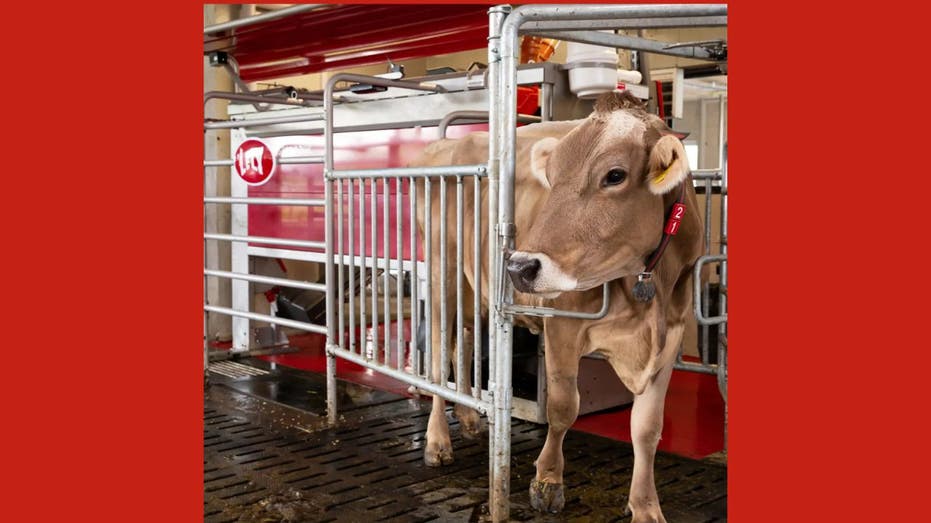Smarter Dairy Farms: The Rise of Robotic Milking

The Future of Dairy Farming: Automation at Its Best
Imagine walking into a modern dairy barn where cows are being milked, fed, and even cleaned—all without a single farmer in sight. This may sound like a scene out of a science fiction movie, but it’s rapidly becoming a reality. Thanks to advanced agricultural robotics, dairy farms are transforming into automated facilities where a team of robots handles essential chores, revolutionizing the dairy farming industry.
Creating a Comfortable Environment for Cows
These cutting-edge robots are not just labor savers; they also prioritize the well-being of the cows. In a fully automated dairy barn, cows have the freedom to choose when they want to be milked. This flexibility often results in more frequent milking sessions compared to the traditional twice-a-day schedule, leading to a more comfortable experience for the animals. This enhanced comfort can increase milk production by approximately 10%, benefiting both farmers and consumers.
Pioneering Robotics: The Lely Astronaut
Founded in 1948 in the Netherlands, Lely has been at the forefront of dairy automation for decades. The company launched its first Astronaut milking robot in the early 1990s and has since developed a range of robotic systems that assist with feeding, cleaning, and ensuring cow comfort. With around 135,000 units deployed globally, Lely is dedicated to revolutionizing dairy farming through robotics.
- Call of Duty Monkeybomb Cable Guy Review: Fun Gaming Controller & Phone Stand Collectible
-
Beware of Fake In-Flight Wi-Fi Networks: Protect Your Data at 30,000 Feet

-
Logitech Announces Discontinuation of Pop Smart Home Buttons, Bricking Devices This October

- Hands-on with Logitech G Pro X: premium sound and comfort for esports players
Streamlining Daily Tasks for Farmers
Traditional dairy farms rely heavily on human labor, dedicating about a third of a farmer’s workday to repetitive tasks like milking, feeding, and manure management. By automating these functions, robots like the Lely Astronaut A5 allow farmers to focus on other critical aspects of their operations. The Astronaut A5 is equipped with a laser-guided arm that cleans the cow’s udder before milking and monitors milk output, collecting data on various health indicators.
Cost-Effective Solutions for Sustainable Farming
The introduction of milking machines in the early 20th century and the rise of rural electrification in the 1950s significantly increased farm sizes and milk yields. Lely believes that robotic technology will enable small dairy farms to scale sustainably. Although the initial investment in dairy robots can be substantial, often running into hundreds of thousands of dollars, the long-term benefits—such as increased milk production and reduced labor costs—can make them a wise investment.
Harnessing AI for Improved Efficiency
Artificial intelligence (AI) plays a vital role in modern dairy farming, optimizing feeding systems, minimizing waste, and enhancing sustainability. Wearable technology and smart sensors are becoming essential tools for monitoring herd health, providing farmers with real-time data to boost cow well-being and productivity.
Cow-Proofing Robotics for Safety and Efficiency
Cows are naturally curious creatures, and their interactions with robots require thoughtful design and programming. Lely engineers have ensured that their robots can operate safely around cows by incorporating features like contact-sensing bumpers and strategically placed emergency stop buttons. Understanding the social dynamics within a herd is crucial; for instance, the Discovery Collector robot is programmed to assert its presence to avoid disruptions by cows.
Empowering Farmers through Technology
As robotic technology becomes more integrated into daily farming life, dairy farmers are transitioning into roles as robot managers. This shift not only allows for greater flexibility but also opens up opportunities for diversification. Some farmers have even expanded their operations to include restaurants and farm shops, allowing customers to observe robotic farming in action while enjoying dairy products made from the cows they are helping care for.
Balancing Tradition with Modern Innovation
Dairy farms are increasingly adopting robotic systems to reduce reliance on hired labor and enhance operational flexibility. Many farmers report that these innovations have allowed them to focus more on their families and personal lives. Moreover, robots can make dairy farming more appealing to younger generations, as the reduced workload associated with robotic farming can attract new talent to the industry.
Looking Ahead: The Evolution of Dairy Farming
So, what does the future hold for dairy farming? Robots are set to play an increasingly significant role, enabling farmers to work smarter, not harder. The ongoing evolution of these technologies will shape the industry in ways we can only begin to imagine.
While robots can handle numerous repetitive tasks, the knowledge and care of farmers remain irreplaceable. These advanced technologies serve as tools that, when used effectively, can enhance the overall well-being of both the farms and the herds.
Final Thoughts: Your Perspective on Robotic Dairy Farming
With this new understanding of robotic dairy farms, how do you feel about purchasing milk from such operations? Has your perception of dairy products changed? Share your thoughts with us and explore the exciting developments in robotic dairy farming.
For more insights and updates, stay connected and subscribe to our newsletter to receive the latest tips and news in technology and farming.
